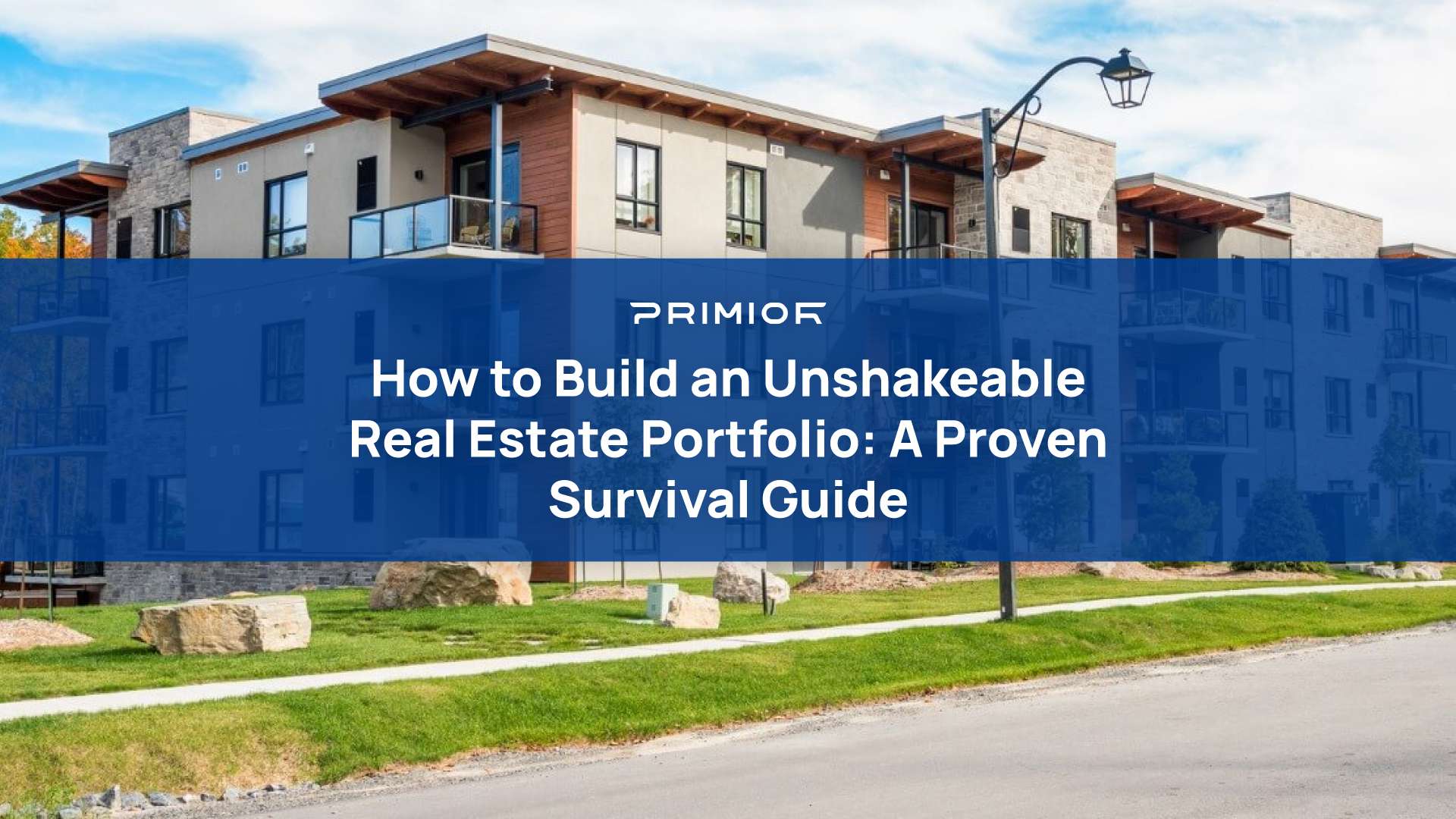Smart investors can get a 2.5x equity multiple from their real estate portfolio. Market cycles typically last 18 years, and with inflation reaching 8.5% in July 2022, success requires more than property acquisition.
Real estate markets cycle through four distinct phases: recovery, expansion, hypersupply, and recession. Each phase needs unique investment approaches, especially when dealing with rising vacancy rates or distressed asset opportunities.
A diverse real estate portfolio is vital to achieve lasting success. Your portfolio becomes resilient against economic changes when you spread investments across property types and locations while keeping strong cash flow.
Want to build an unshakeable real estate portfolio that works in any market? Let’s take a closer look at proven strategies that will drive your success.
Assessing Market Opportunities
Building a successful real estate portfolio begins with systematic market analysis. Properties in prime locations bounce back faster from market downturns and generate steady rental income. The ability to value property correctly in changing markets makes the difference between profitable ventures and expensive mistakes.
Current market analysis
Market analysis needs both property-specific features and broader market conditions. Supply and demand dynamics affect property values directly, while housing inventory levels influence buyer options and price adjustments. Local economic conditions, population growth, and job market stability give us vital insights into market potential.
Market viability depends heavily on median household income. This number helps predict rental pricing potential and assess default risks. Job growth emerges as the most significant metric when evaluating markets. A growing job market signals economic health and leads to population growth, which drives up housing demand and rental rates.
Growth indicators to watch
Market performance and growth potential can be predicted through several key indicators. The Housing Price Index (HPI) tracks changes in residential property values over time. The following metrics also need close attention:
- New construction spending and housing starts data from the U.S. Census Bureau
- Existing home sales reports from the National Association of Realtors
- The NAHB/Wells Fargo Housing Market Index measuring builder confidence
Investors should target locations that show signs of growth and can deliver exceptional cash flow with strong appreciation. Areas with steady population growth—not temporary spikes—often offer the best opportunities. Absorption rates help balance supply and demand, making them essential for pricing and investment decisions.
Creating Your Investment Strategy
“Real estate cannot be lost or stolen, nor can it be carried away. Purchased with common sense, paid for in full, and managed with reasonable care, it is about the safest investment in the world.” — Franklin D. Roosevelt, 32nd President of the United States
Building a successful real estate portfolio starts with a resilient investment framework. We created our strategy to line up with market conditions and personal objectives that create lasting wealth through property investments.
Setting clear investment goals
SMART (Specific, Measurable, Attainable, Relevant, Time-bound) goals are the foundations of your investment strategy. Your net worth goal should target twice your annual salary by age 40 and four times by age 50. Successful investors focus on:
- Portfolio optimization for maximum returns
- Continuous market education and skill development
- Network expansion and team building
- Work-life balance optimization
Developing your unique approach
Your investment approach should match your risk tolerance and financial capacity. Properties that need minimal management provide steady, predictable cash flows for core investments. In spite of that, value-add properties might need large upfront costs but can boost property values and returns over time.
A balanced strategy mixes different investment types. Core-plus investments need minor building improvements with slightly higher risk, offering better potential returns. High-growth areas can provide substantial capital appreciation through opportunistic investments.
Building your investment timeline
Your chosen strategy determines the timeline for real estate investments. Fix-and-flip projects usually take 30-60 days, while large apartment complex acquisitions could need months to a year. These factors matter when you plan your timeline:
Keep your original research phase under 30 days to avoid analysis paralysis. Deal analysis comes next – you’ll need to look at metrics like Net Operating Income (NOI), Cap Rate, and Cash on Cash Return. Each week, analyze a set number of properties to sharpen your deal evaluation skills.
Note that a clear vision of your 12-month objectives leads to long-term success. This method helps alleviate risks through proper planning and goal setting. Different stages of real estate development have varying risk levels, so stay flexible and ready for challenges.
Selecting Strong Investment Properties
“Never count on making a good sale. Have the purchase price be so attractive that even a mediocre sale gives good results.” — Warren Buffet, CEO of Berkshire Hathaway and renowned investor
Finding strong investment properties needs a systematic way to evaluate and check everything thoroughly. Your success in property selection depends on understanding key metrics and spotting red flags that could affect your returns.
Property evaluation checklist
A detailed property evaluation starts with the financial aspects. The property’s potential rental income should match up against the total purchase price. Your monthly rent ideally equals at least one percent of what you invest. You should calculate important metrics like ROI (return on investment) and ARV (after-repair value).
The physical condition of the property substantially affects its investment potential. Here are the vital evaluation factors to look at:
- Structural integrity assessment, including foundation, roof, and major systems
- Age and condition of HVAC, plumbing, and electrical systems
- Presence of potential environmental hazards or contamination
- Signs of deferred maintenance or rushed renovation work
When a property shows promise, you need to do your homework on:
- Financial Records
- Review historical income and expense statements
- Analyze current and projected cash flow
- Check property tax records and utility bills
The property’s legal standing needs a close look. You should verify title status, review existing leases, and check for pending legal issues or disputes. Research zoning regulations and restrictions that might affect future property use or value.
Keep an eye out for warning signs of trouble. Soft or warped sheetrock usually means water damage, while strong room fresheners might hide deeper problems. Properties that change hands often could be trouble spots, as shown in historical sales records.
Income-producing properties need extra attention to:
- Current vacancy rates in the area
- Historical rental rate trends
- Property management costs and requirements
- Ways to add value through improvements
Location features play a vital role in long-term success. Learn about local amenities, school district quality, and job opportunities. Look into planned developments or infrastructure projects that could change property values.
Structuring Your Portfolio
Real estate investing success depends on a well-laid-out portfolio. Research shows institutional investors put 25% to 40% of their total net worth into real estate investments.
Asset allocation strategies
The foundation of a solid real estate portfolio starts with smart asset allocation. We used Modern Portfolio Theory principles to determine the best allocations. Private real estate gives attractive returns per risk unit. Most models cap its allocation because of appraisal lags and valuation frequency.
The sweet spot for real estate allocation ranges from 20% to 30% of the total investment portfolio if you have high net worth. This allocation should spread across different investment vehicles to maximize returns and lower risk.
Balance across property types
Risk management works best when you vary property types. A balanced portfolio needs:
- Residential properties – they give stable demand and steady income
- Commercial spaces – they bring higher potential returns
- Industrial facilities – you get consistent cash flow
- Special-use properties – these create unique opportunities
- Raw land – it offers long-term appreciation potential
Different property types react uniquely to market changes. Commercial properties face higher vacancies while residential rentals show strong performance in today’s market.
Geographic distribution
Geographic diversification protects against local economic downturns and market-specific risks. Investing in different regions can reduce portfolio volatility and boost potential returns.
Japanese markets are great for diversification. They offer high exposure to domestic conditions versus global ones. Markets like India and Brazil give unique opportunities. India’s characteristics match China’s market position from two decades ago.
Smart geographic distribution needs you to look at:
- Local economic indicators
- Population growth trends
- Employment statistics
- Regulatory environments
- Currency fluctuations for international investments
A systematic approach to property evaluation comes from geographic diversification. You need good communication and research to match your investment goals. This approach stops emotional decisions based on local market familiarity.
Maintaining Long-Term Success
Success in real estate investing depends on refining portfolios and responding to market changes. Smart investors rely on analytical insights and strategic planning to keep their portfolios healthy.
Portfolio optimization techniques
Real estate portfolios need a methodical approach to grow value and reduce risks. Research shows 87% of real estate leaders now make portfolio optimization their main goal. Your first step should be data centralization through specialized software that gives you complete portfolio visibility. The next step involves setting up automated systems to track lease expirations, renewals, and compliance, which reduces administrative work. You can then use analytics tools to monitor financial metrics, occupancy rates, and maintenance schedules.
These proven strategies will maximize your returns:
- Analyze and improve space usage
- Set up automated workflows to optimize operations
- Track performance metrics regularly
- Manage leases and retain tenants strategically
- Reduce energy consumption
- Schedule maintenance proactively
Each asset’s contribution to overall performance matters in portfolio optimization. Regular audits help you spot underperforming properties and areas that need improvement. This method cuts unnecessary costs and boosts your investment portfolio’s profitability.
Adapting to market changes
Successful response to market changes needs active monitoring of trends and strategic adjustments. The best investors keep track of economic indicators, demographic changes, and industry developments to predict market movements. This alertness helps them adapt quickly while keeping their portfolios stable.
Risk management stands at the heart of market adaptation. Property type and location diversity helps alleviate market volatility effects. Strong cash reserves also give you flexibility during market swings and let you take advantage of new opportunities.
Technology has become a vital part of effective market adaptation. Up-to-the-minute data analysis and automated monitoring systems show you how your portfolio performs. These tools help you spot potential problems and opportunities quickly, which leads to better decisions about buying, selling, or modifying properties.
The path to successful adaptation balances quick responses with long-term strategic planning. Using technology to monitor portfolios and maintaining solid risk management practices positions your real estate investments for lasting success in markets of all types. This approach, combined with regular portfolio optimization, creates an investment strategy that withstands market cycles and generates steady returns.
Conclusion
A rock-solid real estate portfolio needs careful planning, strategic execution, and continuous optimization. Your foundation for long-term success comes from market analysis skills and clear investment goals. A complete evaluation of property selection criteria will protect your investments from market fluctuations.
Properties of all types and locations make your portfolio more resilient through smart diversification. Institutional investors typically put 25-40% of their net worth into real estate. This shows how important this asset class is for building wealth. Your investments will stay competitive and profitable with regular portfolio optimization supported by technology and analytics.
Note that real estate investing rewards both patience and adaptability. You can build lasting wealth through real estate with systematic market analysis, strategic property selection, and proper portfolio structure. Keep strong cash reserves and respond quickly to market changes. Your long-term investment goals should always stay in focus.
The strength of your real estate portfolio depends on its foundation – solid research, strategic planning, and consistent execution. These proven strategies will help your investment portfolio grow stronger with each carefully selected addition.















